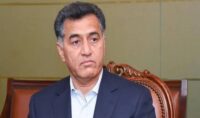Los Angeles, Oct 12 (AFP/APP): Millions of people lost electricity this week in California as the state’s utility giant PG&E sought to prevent catastrophic wildfires, leading many to question whether such power shutoffs will become the new normal.
The unprecedented outages plunged large swaths of Northern California in the dark, forcing the closure of schools and businesses and prompting backlash and questions on how this could happen in a state that boasts the world’s fifth largest economy.
“This can’t be, respectfully, the new normal,” fumed Governor Gavin Newsom on Thursday as he spoke with reporters. “And it is a false choice to say it’s hardship or safety.”
PG&E, the state’s largest private utility company that services some 5.4 million customers in the northern and central part of the state, has defended the shutoffs that affected about two million people as necessary to prevent wildfires that could be sparked by lines downed in heavy winds.
Last November, PG&E’s faulty power lines were determined to have sparked the deadliest wildfire in the state’s modern history, which killed 86 and destroyed the town of Paradise.
Power lines were also behind devastating fires in 2017 in the Napa wine region.
PG&E, which filed for bankruptcy in January, has argued the outages this week were necessary for safety reasons and said it will take days before power is restored to all customers as employees beforehand must check the grid in person or electronically.
Typhoon Hagibis takes aim at Japan
– ‘Not adequately prepared’ –
The beleaguered company also warned that such shutoffs could be ordered annually until its aging power grid and power lines can be updated to handle fire hazards.
Experts believe such an overhaul can take a decade to complete, especially as PG&E is undergoing a massive reorganization linked to the multi-billion dollar settlements it has had to pay victims of last year’s fire.
Bill Johnson, the company CEO, apologized at a news conference Thursday evening for the massive power cuts ordered this week and admitted the agency had poorly handled the issue.
“We were not adequately prepared,” he admitted, while defending the decision. “We faced a choice here between hardship on everyone and safety, and we chose safety.”
His argument, however, was dismissed by many, including the governor, who blasted PG&E for failing to invest enough in recent years to upgrade its power lines.
“It’s decisions that were not made that have led to this moment in PG&E’s history in the state of California,” Newsom told a news conference.
“This is not, from my perspective, a climate change story as much as a story about greed and mismanagement over the course of decades,” he added. “Neglect, a desire to advance not public safety but profits.”
Latest Statement By UN Chief About Climate Change
– ‘Lives disrupted’ –
Mikhael Chester, a professor of sustainable energy at Arizona State University, said even if billions of dollars were spent to upgrade utility grids, power shutdowns would continue to happen as infrastructure could not be expected to be “one hundred percent reliable.”
“We have pushed infrastructure to a point where we are going to have to recognize that reliability is going to become compromised more and more often,” he told Popular Science magazine.
As to suggestions that California bury its power lines underground to ward off wildfire, experts say such a solution comes down to cost and time.
It costs approximately $3 million per mile to convert underground electric distribution lines from overhead, while the cost to build new overhead lines is approximately $150 per foot or $800,000 per mile, PG&E says on its website.
Severin Borenstein, a University of California Berkeley professor of business administration and public policy who specializes in energy, said given the state of affairs, Californians should brace for blackouts becoming regular occurrences.
“We’ve been pretty lucky in California that we have far fewer weather disruptions than in other parts of the country,” he told National Public Radio.
In coming years, however, he added that the state must seriously address the threat of wildfires “and do a lot more preparation and have our lives disrupted for a few days a year at least.”






